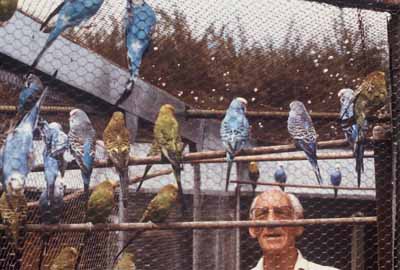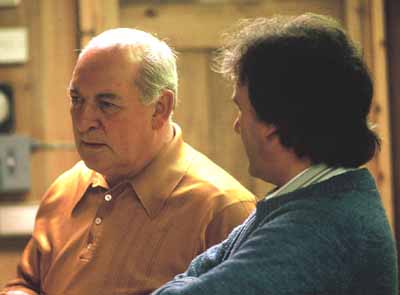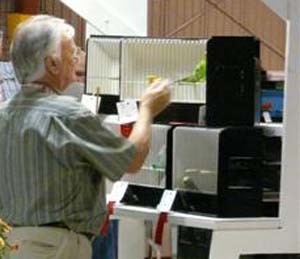Many
newbies to the hobby start by buying and reading every book on
Budgerigars they can find. While the basic information in most
books is sound advice I find that most are very repetitive and
have little new to offer.
Bill was
the one who instilled in me a real love for the budgerigar and a
fascination for all the varieties and colors they could produce.

Eric fed
a basic seed mix, with the emphasis on canary for the higher
protein, seeding grasses and vegetables. He was the first I saw
to introduce animal protein in the form of chicken carcases left
after a family meal… and he also fed dishes of mealworms in the
flights when they were available.
He loved
shows and spent hours preparing his birds, starting a month
before a scheduled show date. His birds were always well
presented and he openly admitted that his showmanship and
preparation often won awards over better quality birds that were
a little rough on the day. One of his buddies was a pigeon
breeder who spayed his birds with water that had a liitle
Listerine and Witch Hazel added and Eric did likewise, This is
what I still use to prepare birds for show today.
Alf
Ormerod – I started writing to Alf in
He had a
real interest in improving varieties. I remember in 1983 when he
and Harry Bryan brought in their first spangles from

When I
first moved to
Winter
was the opposite extreme. It was quite a challenge to make it up
the hill after a snow fall. The breeding shed had a little
insulation in the form of plastic sheeting over the flights, but
you still needed to be rugged up if you planned to stay for
long. Again the breeding pairs and chicks seemed to thrive
although I remember the hens would not spend much time out of
the nest when feeding.
The
second shed was aptly called “The Ice Chest”, wire mesh over the
windows and no insulation at all. First trip up in the morning
Harold would break the ice in the water dish and pour in some
warm water and within minutes all the birds were down at it for
a drink. I often marveled that the birds in this shed survived
any Winter but they certainly hardened to it.
Despite
some of his unauthodox methods Harold taught me that budgies can
survive and breed in extreme temperatures if you have fit,
healthy and hardy stock.
He also
kept amazing records in notebooks for each year and within a few
minutes could give you the pedigree of any bird in his flights
back several generations. He spent hours checking pedigrees when
he was pairing up for the next breeding season. In the 80s I
bred a light green clearwing from a pair of Trethaway birds.
Harold could not believe it initially but started going back
through his pedigree notebooks. Several days later he called to
say he traced both parents back
to an Ormerod cock he had purchased from Ken and Libby Tefft in
Rhode Island, and when he called Alf he was told that bird had
been split for clearwing in the one season he worked with them.
Amazing what pedigrees can tell you.

It was
during one of my visits to Trethaway’s that I first met Eric
Peake from Flint, N Wales who was introduced as a BS Judge and
budding artist. Spending plenty of time with Eric in the 80s I
was able to pick up details on the markings of specific
varieties, feathering and overall balance of our exhibition
budgerigar that only the eyes of an artist would see.
He had a
depth of knowledge on certain varieties, especially clearwings
and cinnamon opalines. that was new to me.
The
biggest influence Eric had on me, and the hobby in USA, was
encouraging other BS Judges to officiate at shows in our
country… and while here hold seminars and slide shows to help
educate the breeders. Eric judged our Blue Chip EBS Show in
Cincinnati several times as did Jeff Attwood, Terry & Claire
Pilkington and Geoff Corser, and when they were here the entries
were our highest ever.

Don
Langell Boxford Massachussetts was nicknamed “The King” of
budgie breeders in USA by Terry & Claire Pilkington during a
visit to Boxford and the name stuck with him for years. And The
King had by far the biggest impact on my knowledge of the
budgerigar and my success on the show bench.
I was
fortunate during the 80s and 90s to have a job that enabled me
to travel to New England several times each year and I always
adjusted the schedule so I spent a day or two with Don and Jean
at Boxford.
During
these visits countless hours were spent in his birdroom and
talking birds around the kitchen table. Don was a master breeder
and once he got to know you every trip to the birdroom was a
learning experience. Always ready to give advice and discuss his
management practices and breeding techniques, Don would often
challenge you to check your knowledge or to test if you really
understood why he did certain things with and for his birds….
And there always was a reason for everything.
More than
anyone else Don was instrumental in developing my eye to see
specific features in a bird. He did this by having me catch up
birds and evaluate them for specific reasons. Much related to
the various families he bred, but could also be used with
budgies in general.
You knew
you had made his inner circle when he would leave the keys so
you could access the birdroom before he was home from his job at
the bank.. But there was always a test in store … Catch up 5
pairs you would breed together and explain why you would mate
them that way… Place the youngsters you thought would develop
into the best show birds or stock birds in show cages and
discuss your reasoning (and write the band numbers of any you
thought would be outstanding on a wall so you could check the
bird again during future visits).
Don had
several families of birds in his aviary, the most prized being
his “Black Band” family that produced the majority of his
Best-In-Show winners. Another test was to catch birds from the
main flight you thought were from the black band line and tell
him what features you saw that were dominant. Initially this was
a tough assignment and if I picked one or two correct I was
happy. As years passed it became easier and easier as you saw
specific “black band” features or even mannerisms. Even today
some 20 years later I will often walk into an aviary or check a
show cage and pick out a bird or two with “Langell blood” to the
surprise of the owner.
Another
key ingredient to the puzzle I learned from Don was to spend
plenty of time observing your birds. Don spent countless hours
in his birdroom, often sitting in a rocking chair while he
puffed on a cigar and watched the birds for signs they were
getting ready to come into breeding condition.
He bred year round when the birds were ready to work and paid little attention to the calendar.
He often
reminded me of my Uncle Bill Petzke years earlier, watching for
cocks to start fighting, rapping the perch with their beak, and
calling to hens in a distinctive tone that more shrill and
different to normal chatter. The hens would be calling too,
laying flat on the perch while pulling their feathers tight till
they had a “snakey look” as Don put it,
and gnawing any piece of
wood in sight. When the appropriate pairs showed these signs
into the breeding cage they went. I am certain this was a major
reason why he had such high fertility year after year.
Nestboxes
were another pet subject with Don that again brought back
memories of my Uncle Bill back when I was a teenager. Don’s
nestboxes were a box-inside-a-box design which was somewhat
radical in the 80s, but quite common today. They hung on the
front of the cage so the entry area was shaded so the hen felt
secure. A handful of pine or cedar shavings was added to the
nest to help stimulate the hen into breeding condition when she
cleaned most of it out.The nest had the usual entry hole but no
vent holes to allow extra air circulation. The outer box was
varnished (for appearance) but the inner box was always uncoated
wood so it could absorb moisture and keep the humidity level
inside the nest high. After eggs were laid Don would cover the
eggs in the concave with his hand and lightly spray water on the
walls of the box to further increase humidity during his twice
daily inspection. He would also mist both parents when they were
out of the nest so they would transfer additional moisture to
the eggs when started sitting again.
Fate has
a strange way of playing it’s hand. I left the hobby for 9 years
due to business commitments… But in early 2009 I received a
phone call to ask if I would speak at a tribute to Don Langell
at the All American later that year. Because I considered him a
close friend I accepted as a way to pay tribute to my most
influential mentor. He taught me so much and we had such great,
fun times together. It did not take long in the show hall
meeting up with old friends before my decision was made to buy a
few pair and get involved again.
On
returning to the hobby it was quite a challenge to get
reasonable quality start-up breeding stock but fortunately
several friends who had been in the hobby when I left were able
to help out with a few pairs. With USA being so large and
serious breeders in far off cities most of the birds were sent
in sight unseen. Fortunately the guys did well by me and shipped
in some fine birds that have bred well during the first two
seasons.
One
aviary I have been able to visit is Gary and Kathy Hicken at
Logan, a suburb of Salt Lake City Utah. Gary has been showing
budgies since 1975 and is currently President of The American
Budgerigar Society as well as a Judge in high demand.
The
Hicken’s have developed their own line of birds over the years
and today have arguably the best stud of birds in the US
frequently dominating the top bench where ever they show.
They have
selectively imported every 3-4 years to maintain vitality and
bring in or develop certain features they want in their stud.
Breeders like Fred Wright, Molkentein and DeBeers are common in
the pedigrees of their birds today. In the past year they added
birds from the Lastella stud which had been influenced by
imports from Daniel Lutolf a few years back.
Once
again there is a lot to be learned by spending time with
breeders like the Hickens and picking their brains. Kathy
handles much of the feeding and day to day management of the
birds while Gary, who is always busy with his duties as local
Chief of Police, takes care of most pairings and the breeding
season.
A few
things stand out apart from Kathy’s regular schedule. They
always buy the best quality feed available and buy in relatively
small quantities so it never sits too long or goes stale. The
birds are fed soaked seed and greens/veges each morning.
The
entire aviary is misted with a fogger every morning with a
solution of water and disinfectant , and birds are misted too.
Gary
strongly believes his best birds consistently produce his best
youngsters so his breeding team is also his show team. To get
full advantage of his very best cocks he runs the best five with
4-5 hens during the breeding season. Chicks are fostered soon
after they hatch, the original hens gets to rest a while, and a
new hen is then introduced into the same cage where the cock is
waiting.
To keep
numbers in check Gary is constantly culling throughout the year.
He limits the maximum number of cocks and hens, so if he wants
to add one of the young cocks to the breeding/show team for next
year he cuts one of the older cocks and it heads to the sales
flight. This ensures he always has his optimum number of both
sexes and that overall quality is always on the improve.
As you
can see, even after 60 plus years in the hobby, there are always
new ideas and techniques to consider introducing into the day to
day management of your stud
Absorb all you hear, then select those that make sense in
your situation and give them a try.
You will
be amazed what you can learn from these mentors with years of
experience in the hobby.
